My Family Background
My family lived in the same village for hundreds of years in Shandong province of China. We owned houses, farmland, and a family cemetery. During the Great Chinese Famine (1958 – 1962), our farm was hit hard by a series of natural disasters: drought, crop diseases, and locusts. Most of our crops were destroyed.
There was not much food left for winter or for lean times. Rather than starve, my family relocated to Tianjin, where my grandma just relocated and settled with a little food to share.
When my family’s situation stabilized somewhat with reliable access to food, my parents gave birth to a baby girl – me. I was the youngest of five children, with two sisters and two brothers. Born as a small and weak baby because of the Great Starvation, I cried often from discomfort and almost suffocated to death by the daycare worker. But it was good that all these didn’t affect my schooling and daily activities and didn’t develop into any illness in China.
Life in Tianjin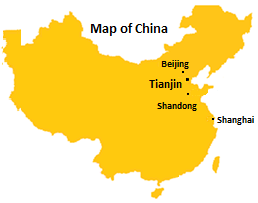
I was born and raised in Tianjin, a coastal city near Beijing in North China. Tianjin is located north of the Shandong Province.
Tianjin means “ferry site of the emperor, the son of heaven.” The port of Tianjin is now China’s largest artificial deep-water harbor.
Tianjin’s climate has:
- A windy spring
- A hot, rainy, and humid summer
- A cool and pleasant fall
- A cold winter
Tianjin is known throughout China for its cuisine and its many local dishes. Tianjin cuisine has strong, slightly salty flavors with a history reaching back to the sixth century CE.
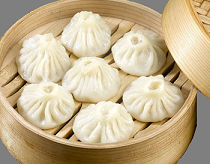 Most Tianjin dishes have flour as a major ingredient. Among the best-known dishes are “The Unique Delicacies of Tianjin”: Goubuli steamed stuffed buns, Guifaxiang (18th Street) fried dough twists, and ear-hole-like fried rice cakes. The most famous Tianjin dish, Goubuli steamed stuffed buns, dates back more than 150 years. Their preparation, including the selection of ingredients, mixing and stirring, rubbing and rolling, is a closely guarded secret.
Most Tianjin dishes have flour as a major ingredient. Among the best-known dishes are “The Unique Delicacies of Tianjin”: Goubuli steamed stuffed buns, Guifaxiang (18th Street) fried dough twists, and ear-hole-like fried rice cakes. The most famous Tianjin dish, Goubuli steamed stuffed buns, dates back more than 150 years. Their preparation, including the selection of ingredients, mixing and stirring, rubbing and rolling, is a closely guarded secret.
In North China, dumplings are another famous tradition and are a popular family meal. These dumplings have a half-moon or ear shape with different fillings. Dumplings served on special occasions, like Chinese New Year’s Eve or as a sendoff for loved ones going on a long trip, represent good wishes and prayers for good fortune. Dumplings at Winter Solstice commemorate the famous Chinese doctor, Zhongjing Zhang (~150 – 219 BCE), for his care and concern not only for his paying patients but for commoners as well.
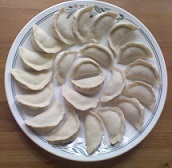 The times my family made dumplings together are some of the happiest memories of my childhood. It was a time of laughter and rambling conversation.
The times my family made dumplings together are some of the happiest memories of my childhood. It was a time of laughter and rambling conversation.
My mother made the dough with wheat flour and water. While the dough was resting, we:
- Washed vegetables and meat
- Cut and chopped meat, vegetables, and spices
- Mixed meat, vegetables, and seasonings together for the filling
When the dough and filling were ready, we sat around a table and made the dumplings. We:
- Kneaded the dough, shaping it into a long log, then cut the log into small pieces.
- Pressed and flattened each piece of dough with our palms into a small disk.
- Used a rolling pin to roll each piece of dough into a thin circular wrapper.
- Filled and shaped each wrapper to make the dumplings
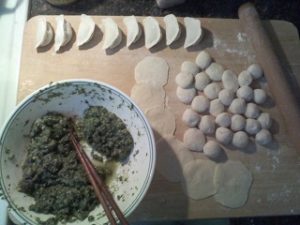 We each had our own task and helped each other as well. Whenever there were only a few wrappers available, one of us stopped wrapping dumplings and made more wrappers; whenever there were a lot of wrappers, one of us stopped rolling wrappers and began wrapping dumplings. The whole family was involved and worked closely together. Sometimes we made dumplings in many different shapes and styles. My siblings and I learned at an early age each step of dumpling-making, as well as the importance of working together.
We each had our own task and helped each other as well. Whenever there were only a few wrappers available, one of us stopped wrapping dumplings and made more wrappers; whenever there were a lot of wrappers, one of us stopped rolling wrappers and began wrapping dumplings. The whole family was involved and worked closely together. Sometimes we made dumplings in many different shapes and styles. My siblings and I learned at an early age each step of dumpling-making, as well as the importance of working together.
When we finished making dumplings, my mother would then boil the dumplings. The rest of us cleaned and set the table, and peeled garlic cloves. We enjoyed our delicious dumplings with garlic and fermented vinegar. Afterward, we enjoyed the dumpling water. Once in a while, there might be a surprise: a special dumpling or two filled with brown sugar, peanuts, egg yolk, or other special ingredients.
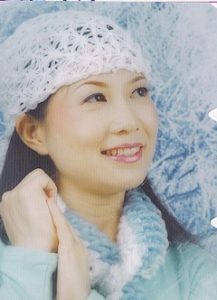 I learned a great deal about cooking and food preparation from my mother and from our neighbors. We Tianjinese like to talk about cooking, particularly about what we eat.
I learned a great deal about cooking and food preparation from my mother and from our neighbors. We Tianjinese like to talk about cooking, particularly about what we eat.
Grocery stores sold grains, beans, meat, vegetables, fruits, spices, and seasonings. In the early morning, local farmers picked vegetables and fruit, butchered animals, and then transported the fresh produce and meat to grocery stores. We went grocery shopping almost every day, except during winter when little fresh produce was to be had. Specialty stores sold fermented vegetables, tofu, vinegar, and soy sauce, and preserved meats. We visited these stores about once a week or when we ran out these items.
Our Diet and Eating Habits
We had three meals every day. Favorite between-meal snacks included walnuts, steamed buns, peaches, and apples.
Breakfast: Chinese families rarely skip breakfast. When my siblings and I were little, my parents would get up early and have breakfast ready when we got up around 7: hot freshly-made soy milk, fried dough or dough sticks, steamed buns, and fermented vegetables or tofu. Sometimes, my mother made the buns with sesame paste, peanut butter, salt and oil, or meat inside.
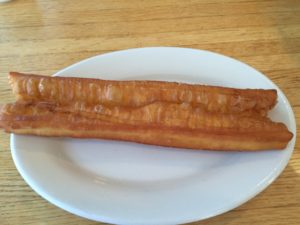 There might be steamed corn bread, rice or millet porridge, or eggs for breakfast. We did not often have eggs because they were usually not available. We were happy to have meat-filled buns or eggs, and had porridge, instead of soymilk, to go with the buns or eggs.
There might be steamed corn bread, rice or millet porridge, or eggs for breakfast. We did not often have eggs because they were usually not available. We were happy to have meat-filled buns or eggs, and had porridge, instead of soymilk, to go with the buns or eggs.
Lunch: There were no cafeterias or vending machines in public schools. We had our own cups for drinking the hot water that was provided by schools.
Morning classes finished around noon. Many of us walked home for lunch. I sometimes took a nap, and then returned to school for afternoon classes. Students, who lived too far from school to walk home at lunch, brought their lunch in stainless steel containers. Lunch containers were collected and put in a huge steamer. Lunches were nicely warm by the end of morning classes. When there was no school, lunch at home was around noon as well.
Lunch consisted of grains, such as rice, wheat, and corn, with stir-fried meat and vegetables.
Dinner: Our family usually ate dinner together at home around 6 pm.
Dinner was mainly grains, stir-fried vegetables with a little or no meat, and soup or porridge. Soups were made with meat and vegetables. Porridges were made from grains or grains mixed with sweet potatoes, beans, or meat.
Most families went to bed around 9 and got up before 7 for school, work, or exercise.
Exercise
During mid-morning breaks, we massaged our faces and ears to relax our eyes. Immediately afterward, we lined up on the school grounds for stretching.
When I was in school, there were no gymnasiums. Physical education classes were held outdoors. We stretched, jogged, jumped, and played athletic games, such as volleyball or relay races.
In college, we did Taiji (also known as Tai Chi) during class breaks. We followed instructions and music broadcast over the school’s public address system for calisthenics. Taiji was part of physical education classes as well. Together with other teachers and students before breakfast and classes, I also practiced Qigong (also known as Chi Kung), another slow motion exercise.
 Today, it is a very common sight to see city residents gather in public squares and green spaces practicing Taiji and Qigong, just as when I was a child. Many times, I saw groups of adults practicing when I passed a public square in the early morning.
Today, it is a very common sight to see city residents gather in public squares and green spaces practicing Taiji and Qigong, just as when I was a child. Many times, I saw groups of adults practicing when I passed a public square in the early morning.
Traditional Chinese Medicine (TCM)
Schoolchildren and young adults rarely visited doctors. But I did once when I was ten.
It was a hot summer. I felt sick and dizzy with a fever. I could not wait for my parents to get home to take care of me.
A clinic was just a five-minute walk from my house. At the clinic, a doctor saw me. She asked if I had had any water before I came to the clinic. I answered, “Yes, a little.” Then she told me to get a cup from her office, go to their hot water room, and have some warm water there. Afterward, she examined my face and told me, “You are fine and you can go home now.”
I did not understand why she said I was fine while I still felt very sick. I left the doctor’s office feverish, dizzy, and disappointed.
As I dragged myself home, I suddenly felt even dizzier and fainter. I broke into a sweat. Then, my body went from feeling heavy to feeling normal. The fever was gone by the time I got home. I felt completely well and was very happy with the doctor.
As a child, I often overheard adults discussing how somebody cured their illness by eating certain foods and avoiding certain others. We young people rarely got sick. But when I did have a fever, a cold, or a cough, my mother made soup for me. She sometimes wrapped me in a warm blanket to ensure that I sweated. After a nap or a good night’s sleep, the illness would be gone.
Traditional Chinese doctors believe that eating the right foods in the right ways at the right times are important for:
- Maintaining healthy digestion
- Properly obtaining energy (qi) and nutrition from food
- Maintaining healthy level of body energy and blood sugar
- Conserving body energy reserves
- Maintaining a healthy weight
- Staying healthy and increasing life expectancy
My University Education
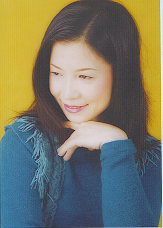 In 1979, China opened its doors to the outside world, after having been closed for almost half a century. Shortly afterward, I applied to universities. My father wanted me to study Traditional Chinese Medicine (TCM). TCM was not very popular at that time. It was easy to get into medical schools, even without high test scores. Because I had very high scores on my exams, it seemed like a waste of my time and talents to attend an “old fashioned” medical school. In the end, I studied computer science, a new and exciting field of study for Chinese students.
In 1979, China opened its doors to the outside world, after having been closed for almost half a century. Shortly afterward, I applied to universities. My father wanted me to study Traditional Chinese Medicine (TCM). TCM was not very popular at that time. It was easy to get into medical schools, even without high test scores. Because I had very high scores on my exams, it seemed like a waste of my time and talents to attend an “old fashioned” medical school. In the end, I studied computer science, a new and exciting field of study for Chinese students.
Even though I did not go to medical school, TCM still fascinated me. I enjoyed reading articles, books, and magazines on food, exercise, healthy living, and longevity. When I was at the university, I even subscribed to Chinese Food at a time when few Chinese language magazines were available.
After completing my university studies, I worked as a professor and researcher in the Computer Science Department at the Civil Aviation University of China in Tianjin, where I met my husband.
A few of my university colleagues went to other countries, especially to the United States. They reported back that life was much better abroad. My husband and I decided to immigrate to the United States. That decision was the first step on an incredible journey to a radically different world and life-long changes for me.
